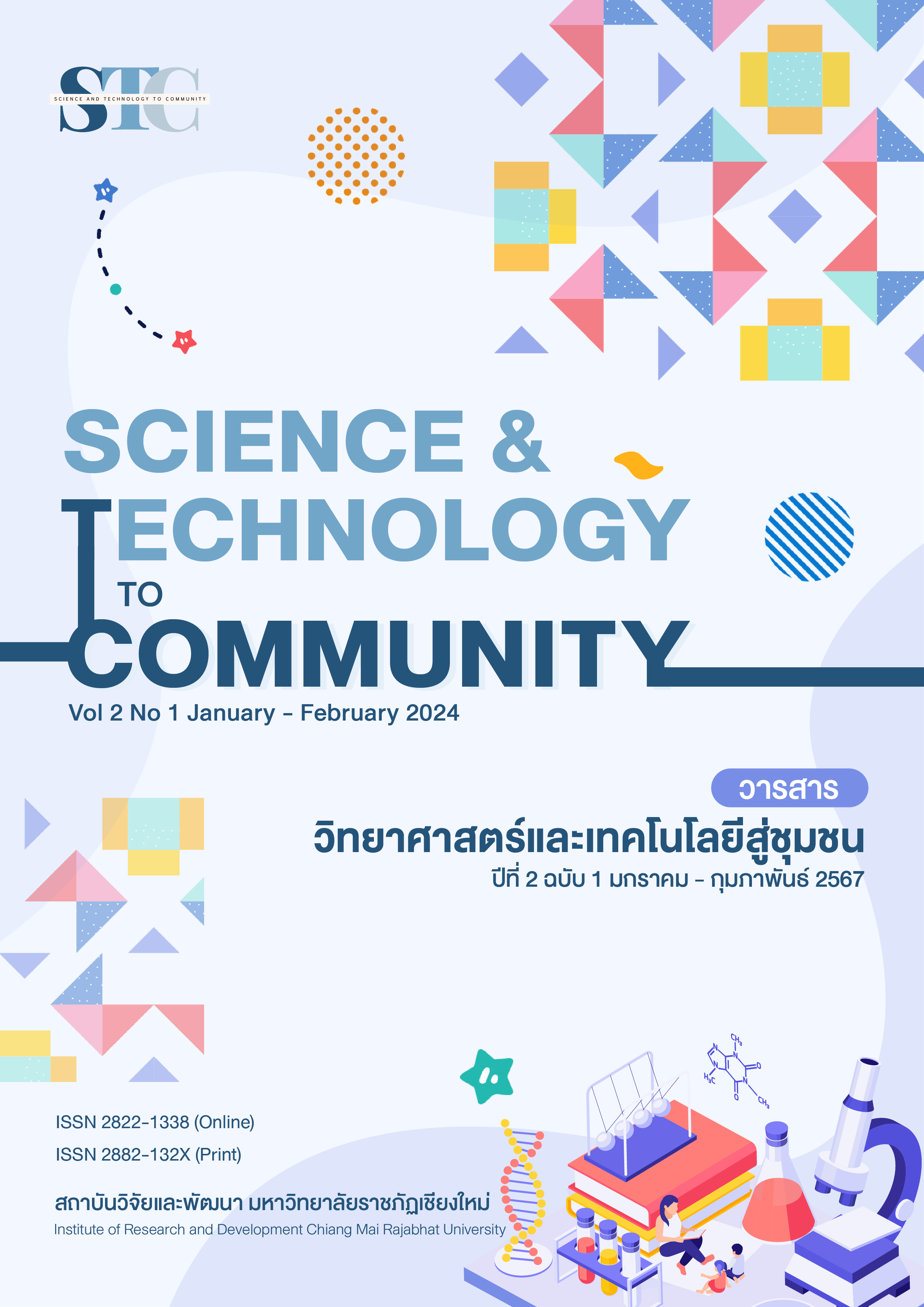ผลของการเตรียมความพร้อมก่อนผ่าตัดเปลี่ยนข้อเข่าเทียมทั้งหมดต่อการฟื้นฟูสมรรถภาพและคุณภาพชีวิตของผู้ป่วยโรคข้อเข่าเสื่อม โรงพยาบาลฝาง จังหวัดเชียงใหม่
DOI:
https://doi.org/10.57260/stc.2024.722คำสำคัญ:
การผ่าตัดเปลี่ยนข้อเข่าเทียม , การฟื้นฟูสมรรถภาพ , คุณภาพชีวิตบทคัดย่อ
การวิจัยครั้งนี้เป็นการวิจัยกึ่งทดลอง มีวัตถุประสงค์เพื่อศึกษาผลของโปรแกรมการเตรียมความพร้อมก่อนผ่าตัดเปลี่ยนข้อเข่าเทียมทั้งหมด ต่อการฟื้นฟูสมรรถภาพ และคุณภาพชีวิตของผู้ป่วยที่ได้รับการผ่าตัดเปลี่ยนข้อเข่าเทียมทั้งหมด กลุ่มตัวอย่างเป็นผู้ป่วยโรคข้อเข่าเสื่อมที่ได้รับการผ่าตัดข้อเข่าเทียมทั้งหมด โดยเลือกกลุ่มตัวอย่างแบบเฉพาะเจาะจงตามคุณสมบัติที่กำหนด จำนวน 56 คน แบ่งเป็นกลุ่มทดลองกลุ่มละ 28 คน และกลุ่มควบคุม 28 คน กลุ่มทดลองได้รับโปรแกรมการเตรียมความพร้อมก่อนการผ่าตัดและได้รับการพยาบาลตามปกติจากพยาบาลประจำการ ส่วนกลุ่มควบคุมได้รับการพยาบาลตามปกติจากพยาบาลประจำการ เครื่องมือที่ใช้ในการวิจัย ได้แก่ โปรแกรมเตรียมความพร้อมการผ่าตัดเปลี่ยนข้อเข่าเทียมทั้งหมดเพื่อการฟื้นฟูสมรรถภาพ การประเมินความปวดแบบตัวเลข การทดสอบความสามารถในการทรงตัว การทดสอบความสามารถในการเคลื่อนไหวของข้อเข่า และแบบประเมินคุณภาพชีวิตโรคสะโพกและข้อเข่าเสื่อมฉบับย่อ การวิเคราะห์ข้อมูล โดยใช้สถิติการวิเคราะห์ความแปรปรวนแบบวัดซ้ำ (Repeated measures ANOVA)
ผลการวิจัยพบว่า กลุ่มทดลองมีค่าเฉลี่ยความปวด น้อยกว่ากลุ่มควบคุม อย่างมีนัยสำคัญทางสถิติ (p-value <0.001 และความสามารถในการทรงตัว (Time up and go test) ดีกว่ากลุ่มควบคุมอย่างมีนัยสำคัญทางสถิติ p-value < 0.001 ) และกลุ่มทดลองมีค่าเฉลี่ยขององศาการงอของข้อเข่าหลังผ่าตัดเพิ่มขึ้น มากกว่ากลุ่มควบคุมอย่างมีนัยสำคัญทางสถิติ (p-value <0.001) การประเมินด้านคุณภาพชีวิต พบว่า กลุ่มทดลองมีค่าเฉลี่ยของคะแนนคุณภาพชีวิตมากกว่ากลุ่มควบคุมอย่างมีนัยสำคัญทางสถิติในด้านคุณภาพชีวิตโดยรวม (p-value <0.001) คะแนนคุณภาพชีวิตในด้านกิจกรรมทางกาย (p-value <0.001) ด้านสุขภาพจิต (p-value <0.001) ด้านแรงสนับสนุนทางสังคม (p-value <0.001) ด้านกิจกรรมทางสังคม (p-value <0.001) และคะแนนคุณภาพชีวิตในด้านความปวดน้อยกว่ากลุ่มควบคุม อย่างมีนัยสำคัญทางสถิติ (p-value <0.001) ผลการศึกษาครั้งนี้สามารถนำไปเป็นแนวทางปฏิบัติในการการฟื้นฟูสมรรถภาพและคุณภาพชีวิตของผู้ป่วยโรคข้อเข่าเสื่อมต่อไป
Downloads
เอกสารอ้างอิง
กรมการแพทย์. (2565). ข้อเข่าเสื่อมในผู้สูงอายุ รักษาได้ ก่อนสายเกิน. สืบค้นจาก https://pr.moph.go.th/index.php?url=pr/detail/2/02/182512/
จิรวรรณ ตันวัฒนะ และคณะ. (2545). ผลของการออกกำลังกล้ามเนื้อหน้าขาด้วยวิธีประยุกต์ในผู้ป่วยข้อเข่าเสื่อม. เวชศาสตร์ฟื้นฟูสาร, 12(1), 32-43. https://www.rehabmed.or.th/main/wp-content/uploads/2015/01/L-168.pdf
ณัชชา ตระการจันทร์ และ พัศจีพร ยศพิทักษ์. (2563). การฟื้นฟูสมรรถภาพหลังผ่าตัดเปลี่ยนข้อเข่าเทียม. วารสารศูนย์อนามัยที่ 9, 14(34), 271-284. https://he02.tci-thaijo.org/index.php/RHPC9Journal/article/view/242035
ดารารัตน์ นวมทอง, วรรณภา ลีพิทักษ์วัฒนา และ อินทร์ธีรา พัฒน์ปรียากุล. (2562). การเปรียบเทียบความสามารถในการใช้งานข้อเข่าระหว่างก่อนและหลังได้รับโปรแกรมการบริหารข้อเข่าในผู้ป่วยโรคข้อเข่าเสื่อมโรงพยาบาลศูนย์เจ้าพระยายมราชจังหวัดสุพรรณบุรี. วารสารวิทยาลัยพยาบาลบรมราชชนนี สุพรรณบุรี, 2(1), 64-84. https://he02.tci-thaijo.org/index.php/SNC/article/view/243023
ดวงพร สุรินทร์ และ สยัมภู ใสทา. (2566). ประสิทธิผลของโปรแกรมการจัดการตนเองด้วยการออกกำลังกายกล้ามเนื้อรอบข้อเข่าร่วมกับการประคบร้อนในผู้สูงอายุภาวะข้อเข่าเสื่อมเครือข่ายบริการปฐมภูมิโรงพยาบาลห้างฉัตร จังหวัดลำปาง. วารสารกายภาพบำบัด, 45(2), 97-111. https://he02.tci-thaijo.org/index.php/tjpt/article/view/258747
พิชญ์ประอร ยังเจริญ , สุภาพ อารีเอื้อ และ นันทิกานต์ แสงทอน. (2562). ปัจจัยทำนายคุณภาพชีวิตของผู้ป่วยสูงอายุหลังผ่าตัดเปลี่ยนข้อเข่าเทียม. วารสารพยาบาลตำรวจ, 11(1), 47-60. https://he01.tci-thaijo.org/index.php/policenurse/article/view/118355
มนทกานต์ ยอดราช และ ทัศนา ชูวรรธนะปกรณ์. (2014). ผลของโปรแกรมการให้ข้อมูลเตรียมความพร้อมร่วมกับการออกกำลังกายด้วย ยางยืดต่อความรู้และความสามารถในการทำหน้าที่ของร่างกายของผู้สูงอายุ หลังผ่าตัดเปลี่ยนข้อเข่าเทียม. วารสารพยาบาลกระทรวงสาธารณสุข, 23(3), 63-75. https://he02.tci-thaijo.org/index.php/tnaph/article/view/16628
สำนักงานหลักประกันสุขภาพแห่งชาติ. (2564). ชุดข้อมูลอัตราการผ่าตัดเปลี่ยนข้อเข่าในผู้สูงอายุ 60 ปีขึ้นไป สิทธิ UC ของโรงพยาบาลที่ให้บริการ ปี 2560 – 2563. สืบค้นจาก https://data.go.th/dataset/dataset-ip_21_03
An, J., Ryu, H. K., Lyu, S. J., Yi, H. J., & Lee, B. H. (2021). Effects of Preoperative Telerehabilitation on Muscle Strength, Range of Motion, and Functional Outcomes in Candidates for Total Knee Arthroplasty: A Single-Blind Randomized Controlled Trial. Int J Environ Res Public Health, 18(11). https://doi.org/10.3390/ijerph18116071
Aree-Ue, S., Kongsombun, U., Roopsawang, I., & Youngcharoen, P. (2019). Path model of factors influencing health-related quality of life among older people with knee osteoarthritis. Nursing & Health Sciences, 21(3), 345-351. https://onlinelibrary.wiley.com/doi/10.1111/nhs.12602
Bandura, A. (1986). Social foundations of thought and action: A social cognitive theory. Englewood Cliffs, NJ, US: Prentice-Hall, Inc.
Calatayud, J., Casaña, J., Ezzatvar, Y., Jakobsen, M. D., Sundstrup, E., & Andersen, L. L. (2017). High-intensity preoperative training improves physical and functional recovery in the early post-operative periods after total knee arthroplasty: a randomized controlled trial. Knee Surg Sports Traumatol Arthrosc, 25(9), 2864-2872. https://doi.org/10.1007/s00167-016-3985-5
Canovas, F., & Dagneaux, L. (2018). Quality of life after total knee arthroplasty. Orthop Traumatol Surg Res, 104(1s), S41-s46. https://doi.org/10.1016/j.otsr.2017.04.017
Dávila Castrodad, I. M., Recai, T. M., Abraham, M. M., Etcheson, J. I., Mohamed, N. S., Edalatpour, A., & Delanois, R. E. (2019). Rehabilitation protocols following total knee arthroplasty: a review of study designs and outcome measures. Ann Transl Med, 7(Suppl 7), S255. https://doi.org/10.21037/atm.2019.08.15
Downie, W. W., Leatham, P. A., Rhind, V. M., Wright, V., Branco, J. A., & Anderson, J. A. (1978). Studies with pain rating scales. Annals of the Rheumatic Diseases, 37, 378-381. https://doi.org/10.1136/ard.37.4.378
Gränicher, P., Stöggl, T., Fucentese, S. F., Adelsberger, R., & Swanenburg, J. (2020). Preoperative exercise in patients undergoing total knee arthroplasty: a pilot randomized controlled trial. Arch Physiother, 10, 13. https://doi.org/10.1186/s40945-020-00085-9
Guillemin, F., Rat, A. C., Goetz, C., Spitz, E., Pouchot, J., & Coste, J. (2016). The Mini-OAKHQOL for knee and hip osteoarthritis quality of life was obtained following recent shortening guidelines. Journal of Clinical Epidemiology, 69, 70-78. https://doi.org/10.1016/j.jclinepi.2015.06.010
Huber, E. O., Roos, E. M., Meichtry, A., De Bie, R. A., & Bischoff-Ferrari, H. A. (2015). Effect of preoperative neuromuscular training (NEMEX-TJR) on functional outcome after total knee replacement: an assessor-blinded randomized controlled trial. BMC Musculoskeletal Disorders, 16(1), 101. https://doi.org/10.1186/s12891-015-0556-8
Kondo, Y., Yoshida, Y., Iioka, T., Kataoka, H., Sakamoto, J., Hirase, T., Honda} Y., Nawata} A., & Okita, M. (2022). Short-Term Effects of Isometric Quadriceps Muscle Exercise with Auditory and Visual Feedback on Pain, Physical Function, and Performance after Total Knee Arthroplasty: A Randomized Controlled Trial. Journal of Knee Surgery, 35(8), 922-931. https://doi.org/10.1055/s-0040-1721035
Long, H., Liu, Q., Yin, H., Wang, K., Diao, N., Zhang, Y., Lin, J., & Guo, A. (2022). Prevalence Trends of Site-Specific Osteoarthritis From 1990 to 2019: Findings From the Global Burden of Disease Study 2019. Arthritis & Rheumatology, 74(7), 1172-1183. https://doi.org/10.1002/art.42089. Epub 2022 Jun 2. PMID: 35233975; PMCID: PMC9543105
Ma, J. X., Zhang, L. K., Kuang, M. J., Zhao, J., Wang, Y., Lu, B., Sun, L., & Ma, X. L. (2018). The effect of preoperative training on functional recovery in patients undergoing total knee arthroplasty: A systematic review and meta-analysis. Int J Surg, 51, 205-212. https://doi.org/10.1016/j.ijsu.2018.01.015
Matassi, F., Duerinckx, J., Vandenneucker, H., & Bellemans, J. (2014). Range of motion after total knee arthroplasty: the effect of a preoperative home exercise program. Knee Surg Sports Traumatol Arthrosc, 22(3), 703-709. https://doi.org/10.1007/s00167-012-2349-z
Mat Eil Ismail, M. S., Sharifudin, M. A., Shokri, A. A., & Ab Rahman, S. (2016). Preoperative physiotherapy and short-term functional outcomes of primary total knee arthroplasty. Singapore Med J, 57(3), 138-143. https://doi.org/10.11622/smedj.2016055
Papalia, R., Vasta, S., Tecame, A., D'Adamio, S., Maffulli, N., & Denaro, V. (2013). Home-based vs supervised rehabilitation programs following knee surgery: A systematic review. British Medical Bulletin, 108, 55-72. https://doi.org/10.1093/bmb/ldt014
Podsiadlo, D., & Richardson, S. (1991). The timed "Up & Go": A test of basic functional mobility for frail elderly persons. Journal of the American Geriatrics Society, 39(2), 142-148. https://doi.org/10.1111/j.1532-5415.1991.tb01616.x
Price, A. J., Alvand, A., Troelsen, A., Katz, J. N., Hooper, G., Gray, A., Carr, A., & Beard, D. (2018). Knee replacement. The Lancet, 392(10158), 1672-1682. https://doi.org/10.1016/S0140-6736(18)32344-4
Rittharomya, J., Aree-ue, S., Malathum, P., Orathai, P., Belza, B., & Kawinwonggowit, V. (2020). The Effectiveness of Preoperative Quadriceps Exercise and Diet Control Program for Older Adults Waiting for Total Knee Arthroplasty: A Randomized Controlled Trial. Pacific Rim International Journal of Nursing Research, 24(4), 485–501. https://he02.tci-thaijo.org/index.php/PRIJNR/article/view/228023
Schroer, W. C., Berend, K. R., Lombardi, A. V., Barnes, C. L., Bolognesi, M. P., Berend, M. E., Ritter, M. A., & Nunley, R. (2013). Why are total knees failing today? Etiology of total knee revision in 2010 and 2011. The Journal of Arthroplasty, 28(8 Suppl), 116-119. https://doi.org/10.1016/j.arth.2013.04.056
ดาวน์โหลด
เผยแพร่แล้ว
รูปแบบการอ้างอิง
ฉบับ
ประเภทบทความ
สัญญาอนุญาต
ลิขสิทธิ์ (c) 2023 วิทยาศาสตร์และเทคโนโลยีสู่ชุมชน

อนุญาตภายใต้เงื่อนไข Creative Commons Attribution-NonCommercial-NoDerivatives 4.0 International License.
1. บทความ ข้อมูล เนื้อหา รูปภาพฯลฯ ที่ได้รับการตีพิมพ์ใน “วารสารวิทยาศาสตร์และเทคโนโลยีสู่ชุมชน” ถือเป็นลิขสิทธิ์ของวารสารวิทยาศาสตร์และเทคโนโลยีสู่ชุมชน มหาวิทยาลัยราชภัฏเชียงใหม่ หากบุคคลหรือหน่วยงานใดต้องการนำทั้งหมดหรือส่วนหนึ่งส่วนใดไปเผยแพร่ต่อหรือกระทำการใดๆ จะต้องได้รับอนุญาตเป็นลายลักษณ์อักษรจาก วารสารวิทยาศาสตร์และเทคโนโลยีสู่ชุมชน มหาวิทยาลัยราชภัฏเชียงใหม่
2. เนื้อหาบทความที่ปรากฏในวารสารเป็นความรับผิดชอบของผู้เขียนบทความโดยตรง ซึ่งกองบรรณาธิการวารสารไม่จำเป็นต้องเห็นด้วยหรือร่วมรับผิดชอบใดๆ














